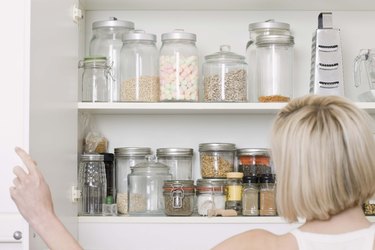
The exterior walls of your home contain insulation that creates an envelope around the living areas of your home. Installing recessed shelves in an exterior wall limits the space available for insulation and creates a gap in the drywall that can allow outside air to enter your home if it's not sealed properly. If you install recessed shelving in an exterior wall, you'll need to provide adequate insulation and air sealing to maintain your home's thermal envelope.
Insulation
Video of the Day
Insulation is rated using the R-value system, which rates insulation based on how effectively it prevents heat from moving from one place to another. The R-value of your insulation depends on its type and thickness. Exterior walls typically require enough insulation to provide an R-value of 20 or more, according to Missouri State University. Installing recessed shelving can restrict the space left for insulation so it cannot meet the recommended levels. To maintain an effective level of insulation behind your recessed shelves, you can install high-density foam board insulation that requires only 3 or 4 inches of space.
Video of the Day
Moisture Barrier
The insulation in your exterior wall contains a moisture barrier. If you need to install new insulation to cover your recessed shelving, you should install plastic sheeting between the outside of the wall and the insulation. You can secure the moisture barrier to the wall studs on either side of your shelves using staples. The moisture barrier needs to provide a continuous barrier from the floor to the ceiling.
Air Sealing
Preventing air from entering your home through gaps around your recessed shelves ensures they don't reduce the energy efficiency of your home. Once shelves are secured in place, look for gaps between the shelves and the drywall around it. You can use drywall putty to fill these gaps and create an effective barrier against outside air.
Considerations
Before installing recessed shelving, ensure no electrical lines are running through the wall. Insulate the wall cavity below the recessed shelving. If this cavity is left open, air can flow from the basement into your home. If you decide to use loose-fill or batt insulation to fill the gap behind the shelving, ensure it's not stretched or compressed, which can crush the air pockets built into your insulation and decrease its effectiveness.